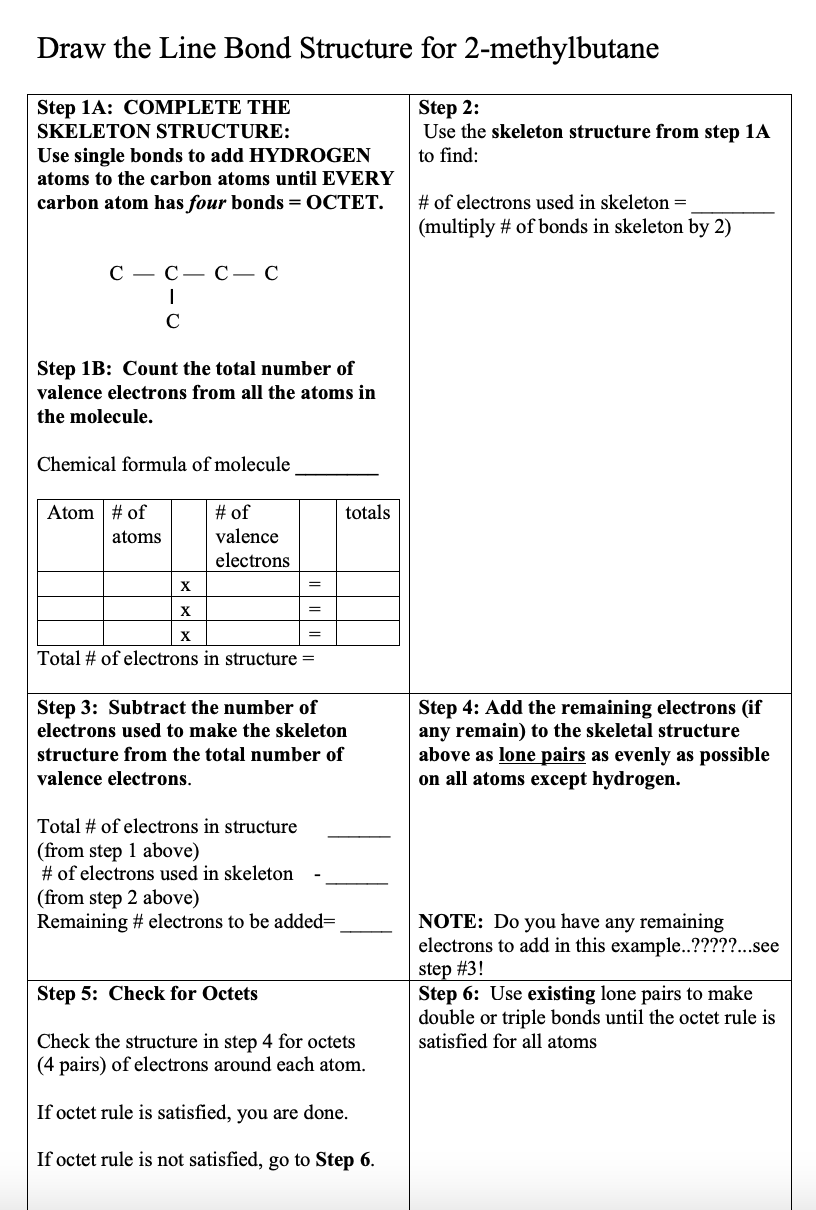Draw the Line Bond Structure for 2-methylbutane Step 1A: COMPLETE THE SKELETON STRUCTURE: Step 2: Use the skeleton structure from step 1A to find: Use single bonds to add HYDROGEN atoms to the carbon atoms until EVERY carbon atom has four bonds = OCTET. C C I Step 1B: Count the total number of valence electrons from all the atoms in the molecule. Chemical formula of molecule Atom # of C atoms X X X # of valence electrons = = = Total # of electrons in structure = totals Step 3: Subtract the number of electrons used to make the skeleton structure from the total number of valence electrons. Total # of electrons in structure (from step 1 above) # of electrons used in skeleton (from step 2 above) Remaining # electrons to be added= Step 5: Check for Octets Check the structure in step 4 for octets (4 pairs) of electrons around each atom. If octet rule is satisfied, you are done. If octet rule is not satisfied, go to Step 6. # of electrons used in skeleton = (multiply # of bonds in skeleton by 2) Step 4: Add the remaining electrons (if any remain) to the skeletal structure above as lone pairs as evenly as possible on all atoms except hydrogen. NOTE: Do you have any remaining electrons to add in this example..?????...see step #3! Step 6: Use existing lone pairs to make double or triple bonds until the octet rule is satisfied for all atoms
Formal Charges
Formal charges have an important role in organic chemistry since this concept helps us to know whether an atom in a molecule is neutral/bears a positive or negative charge. Even if some molecules are neutral, the atoms within that molecule need not be neutral atoms.
Polarity Of Water
In simple chemical terms, polarity refers to the separation of charges in a chemical species leading into formation of two polar ends which are positively charged end and negatively charged end. Polarity in any molecule occurs due to the differences in the electronegativities of the bonded atoms. Water, as we all know has two hydrogen atoms bonded to an oxygen atom. As oxygen is more electronegative than hydrogen thus, there exists polarity in the bonds which is why water is known as a polar solvent.
Valence Bond Theory Vbt
Valence bond theory (VBT) in simple terms explains how individual atomic orbitals with an unpaired electron each, come close to each other and overlap to form a molecular orbital giving a covalent bond. It gives a quantum mechanical approach to the formation of covalent bonds with the help of wavefunctions using attractive and repulsive energies when two atoms are brought from infinity to their internuclear distance.
I don't get it with this question. Can you help me, please

Step by step
Solved in 2 steps with 1 images









